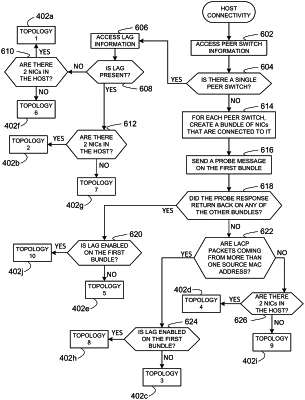| CPC H04L 41/0886 (2013.01) [H04L 41/0803 (2013.01); H04L 41/12 (2013.01); H04L 45/02 (2013.01); H04L 49/40 (2013.01); H04L 49/70 (2013.01)] | 27 Claims |

|
1. An apparatus to determine network topologies, the apparatus comprising:
memory;
instructions; and
programmable circuitry, the instructions to cause the programmable circuitry to at least:
cause transmission of a probe message on a first bundle of network interface cards connected to a peer switch;
access a data store including rules corresponding to a first network topology, a second network topology, and a third network topology;
after a probe response is received on a second bundle of network interface cards based on the probe message, determine that a network topology of a host is the first network topology based on a determination of whether a link aggregation group (LAG) is enabled on the first bundle of network interface cards; and
when the probe response is not received on the second bundle of network interface cards based on the probe message:
determine that the network topology of the host is the second network topology based on whether the LAG is enabled on the first bundle of network interface cards; or
determine that the network topology of the host is the third network topology based on a quantity of network interface cards in the host.
|